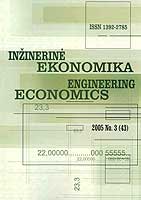Classification of Non-Tariff Barriers in the International Textile Trade Markets
Classification of Non-Tariff Barriers in the International Textile Trade Markets
Author(s): Vytautas Snieška, Bronius Neverauskas, Aida ZigmantavičienėSubject(s): Economy
Published by: Kauno Technologijos Universitetas
Keywords: classification of nontariff barriers; classifica-tion; international textile trade.
Summary/Abstract: Historically the role of non-tariff barriers (NTBs) in the international textile trade gained strength when World Trade Organization (WTO) signed the Agreement on Textile and Clothing in 1995. The main emphasis of it was four stage gradual reductions of quotas as the most influential non-tariff trade barrier within 10 years period of time ending January 1, 2005. The Agreement also provided the reduction of all other types trade bar-riers in order to liberate international trade. However, the traditional non-tariff barriers to trade found re-placement by modern trade distortions. There is no doubt about their existence but they are not widely in-vestigated especially in terms of non-tariff barriers in the textile trade. The research is studying the classifica-tion of non-tariff barriers, the influence of the barriers to the international trade in textiles, discusses its specif-ics in the context of European Union. The survey is looking for the best option to classify non-tariff barriers in the international textile trade markets and examines variety of their aspects. Scientific and other sources do not provide any spe-cific classification of non-tariff barriers to the textile trade. Though, the NTBs are widely and deeply investi-gated in terms of world and regional trade, separate industries, even individual companies and products. The aim of this survey is to analyse the classifica-tion of non-tariff barriers in the international textile trade markets and to ground its principles on EU and world trade. First, the article presents different definitions of non-tariff barriers and existing classification systems of NTBs. Comprehensive extensions are related to a few most general but scientifically explored enough grouping: administrative procedures, market structure and politi-cal, social and cultural or so called institutional fac-tors. Each group includes a great number of variuos non-tariff barriers. The empiric test is based on the top EU textile ex-port countries and seeks for the following aims: to iden-tify non-tariff barriers, most influential to the related markets, to compare the degree of market protection to the EU clothing export flows and to resume the classifi-cation of NTBs suitable for textile sector. The test results conclude that individual barriers have different power to influence trade flows, the same name of the barrier may have different interpretation and regulation in every country and create different barriers in terms of significance. The article acknowledges the existance of a great number of NTBs in textile trade especially having in mind their different interpretation in separate markets and different influence as an outcome. The survey sum-marizes highlighting classification of Doha Develop-ment Agenda as a principle general classification to ground identification and classification of NTBs in in-ternational textile trade.
Journal: Engineering Economics
- Issue Year: 2006
- Issue No: 2 (47)
- Page Range: 45-53
- Page Count: 9
- Language: English

